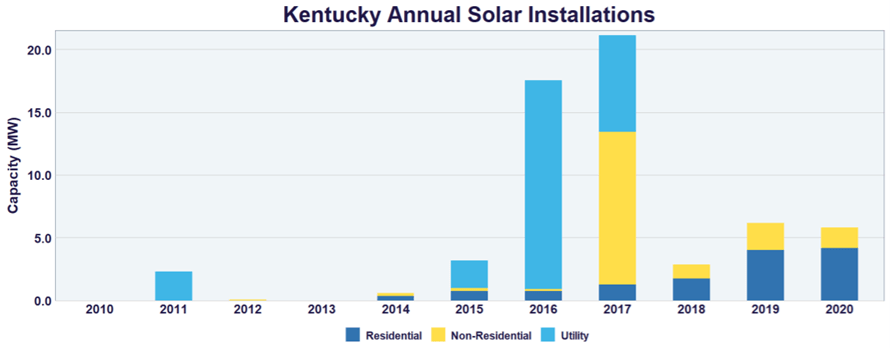The state of Kentucky was long been synonymous with the coal industry. That perception may still hold some truth today, but solar is no longer the afterthought that it once was in this fossil fuels-rich state.
A Nascent Industry Finding its Footing
Even by the most optimistic of outlooks, Kentucky’s solar industry is just barely beginning its growth journey. As of 2020, the state could lay claim to having 59.53 MW of cumulative installed solar capacity, a figure that was good for a rather humbling ranking of 48th out of the 50 U.S. states. A meager 0.1% of the state’s electricity was generated from solar sources.
For perspective, the leading solar state in the country, California, had 31,288 MW of cumulative installed solar capacity in 2020, and just under 23% of the state’s electricity was generated from solar.
Kentucky’s position relative to its peers may not be overly impressive, but the trendline is clear. Just 10 short years ago Kentucky had basically no installed solar capacity (0.2 MW). The SEIA projects that the state may clear 845 MW of installed capacity by as soon as 2025, as costs continue to plummet and favorable pro-solar policies entrench themselves at the state level.
Turning Lemons into Lemonade
In a strange twist of irony, the prospects of the state of Kentucky’s solar industry may rest in the coalfields that have anchored the state’s energy production capabilities – and cultural identity – for generations.
Carbon offsets are a popular way for corporations pursuing sustainability goals to achieve the “net” in their net-zero emissions goals. Carbon offsets essentially work as credits that companies can leverage to offset operations that are otherwise not carbon neutral. Kentucky’s nascent solar industry positions the state well to benefit from these offsets, given the state’s still heavy reliance on fossil fuels. About 73% of the state’s electricity generated in 2019 came from coal. Carbon offsets can be quicker to achieve and be far more impactful in a place like Kentucky, as opposed to say just building another solar farm in California.
Kentucky’s hundreds of thousands of acres of coalfields (many of which are abandoned) represent an interesting adaptive reuse opportunity for solar developers. Just last month, the state of Kentucky unveiled a web-based tool to make it easier for solar developers to site arrays on reclaimed mine lands in the state.
Kentucky’s eastern most county – Pike County – will soon be the home to one such solar array which will be affixed to land that formerly operated as a coal mine. First announced in 2017, the solar array will occupy 700 acres on a former strip mine on Kentucky’s Bent Mountain and it will consist of over half a million solar panels. Global auto manufacturing giant, Toyota, is partnering on the solar project and providing a critical boost to the economics of the project by committing to a 15 to 20-year power purchase agreement (PPA).
Renewables-Minded Corporations Providing Momentum
Unlike more established state solar markets, residential solar is not a primary driver of solar growth in Kentucky. Installed residential solar capacity has ticked up in recent years, but it still barely registers as a blip on the radar with regards to the state’s overall solar capacity. A somewhat humorous example of this is this story from earlier in the year highlighting a Tesla solar rooftop owner in Louisville who is the only Tesla solar roof homeowner within 500 miles of Louisville.
Kentucky’s recent solar success and promising future is owed mainly to the growing number of major corporations with ambitious renewable energy goals that are committing to power purchase agreements (PPA) for solar farms in the state.
In May, Acciona Energy got the greenlight from regulators to build a 188-MW solar farm, one of multiple that the company plans to build to serve the needs of Amazon. Acciona and Amazon inked a deal last December committing Amazon to buy 641 MW of electricity from multiple solar arrays in Kentucky, Ohio, and Illinois. In March, the Tennessee Valley Authority made public their plans to develop a 173 MW solar-plus-storage project just outside of Bowling Green, KY that would power a nearby data center for Facebook and a nearby production facility for General Motors. Meanwhile, Dow and Toyota are the beneficiaries of a 100-MW solar farm just south of Louisville that is expected to be commercially operational next year.
Industry Gets Major Jolt from Recent Ruling
The days of Kentucky’s residential solar market largely taking a backseat to the state’s overall solar picture may be numbered, though, thanks to a pivotal state ruling expected to give the residential market a major jolt in the arm.
Just a couple months ago, Kentucky’s Public Service Commission (PSC) released a precedent setting ruling on net metering that greatly favors residential solar users. The PSC ruling tabbed the offset for excess electricity sent back to the grid by solar users at $0.09/Kwh, which was 3 times higher than the $0.03/Kwh level that Kentucky Power – a utility company serving 100,000+ households in Eastern Kentucky – was advocating for.
Prior to this recent ruling, Kentucky solar homeowners were credited for every Kwh of energy that was sent back to the grid and Kentucky Power sold that excess energy to neighboring utilities for the retail price of $0.11/Kwh. When Kentucky Power proposed their latest rate hike, the utility company tried to lower that compensation rate significantly, which among other things, would have significantly stunted growth prospects for the state’s resident solar market.
The PSC wasn’t having it. It is worth noting what a relief (and surprise) the PSC’s ruling was. Kentucky Power has long been a thorn in the side for Kentucky’s solar industry, and public policy victories and favorable regulator rulings have been hard to come by for Kentucky’s solar advocates. The PSC’s ruling ensures that the financial incentives for solar homeowners remain strong in Kentucky, just like they are in so many other U.S. states.
It will be worth following where Kentucky’s solar industry goes from here. The PSC’s ruling on net metering, the growing interest in corporate PPAs in the state, the expansive development opportunities on old coal mines, and the constantly improving solar economics in the state vis-à-vis coal all combine to put a lot of wind at the sails of the state’s nascent solar industry.
The proof will be in the pudding, but the symbolism is clear – the benefits of solar energy are breaking through in the heart of coal country.
Cover Photo Source: Inside Climate News








